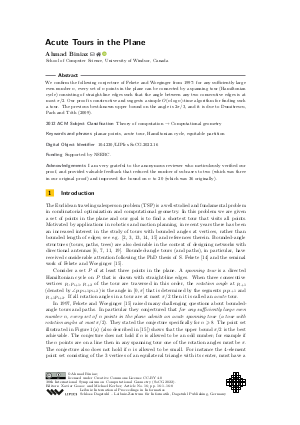Acute Tours in the Plane
Author
Ahmad Biniaz 
-
Part of:
Volume:
38th International Symposium on Computational Geometry (SoCG 2022)
Part of: Series: Leibniz International Proceedings in Informatics (LIPIcs)
Part of: Conference: Symposium on Computational Geometry (SoCG) - License:
 Creative Commons Attribution 4.0 International license
Creative Commons Attribution 4.0 International license
- Publication Date: 2022-06-01
File

PDF
LIPIcs.SoCG.2022.16.pdf
- Filesize: 0.73 MB
- 8 pages
Document Identifiers
Subject Classification
ACM Subject Classification
- Theory of computation → Computational geometry
Keywords
- planar points
- acute tour
- Hamiltonian cycle
- equitable partition
Metrics
- Access Statistics
-
Total Accesses (updated on a weekly basis)
0PDF Downloads0Metadata Views
Abstract
We confirm the following conjecture of Fekete and Woeginger from 1997: for any sufficiently large even number n, every set of n points in the plane can be connected by a spanning tour (Hamiltonian cycle) consisting of straight-line edges such that the angle between any two consecutive edges is at most π/2. Our proof is constructive and suggests a simple O(nlog n)-time algorithm for finding such a tour. The previous best-known upper bound on the angle is 2π/3, and it is due to Dumitrescu, Pach and Tóth (2009).
Cite As Get BibTex
Ahmad Biniaz. Acute Tours in the Plane. In 38th International Symposium on Computational Geometry (SoCG 2022). Leibniz International Proceedings in Informatics (LIPIcs), Volume 224, pp. 16:1-16:8, Schloss Dagstuhl – Leibniz-Zentrum für Informatik (2022)
https://doi.org/10.4230/LIPIcs.SoCG.2022.16
BibTex
@InProceedings{biniaz:LIPIcs.SoCG.2022.16,
author = {Biniaz, Ahmad},
title = {{Acute Tours in the Plane}},
booktitle = {38th International Symposium on Computational Geometry (SoCG 2022)},
pages = {16:1--16:8},
series = {Leibniz International Proceedings in Informatics (LIPIcs)},
ISBN = {978-3-95977-227-3},
ISSN = {1868-8969},
year = {2022},
volume = {224},
editor = {Goaoc, Xavier and Kerber, Michael},
publisher = {Schloss Dagstuhl -- Leibniz-Zentrum f{\"u}r Informatik},
address = {Dagstuhl, Germany},
URL = {https://drops.dagstuhl.de/entities/document/10.4230/LIPIcs.SoCG.2022.16},
URN = {urn:nbn:de:0030-drops-160240},
doi = {10.4230/LIPIcs.SoCG.2022.16},
annote = {Keywords: planar points, acute tour, Hamiltonian cycle, equitable partition}
}
Author Details
Funding
Supported by NSERC.
Acknowledgements
I am very grateful to the anonymous reviewer who meticulously verified our proof, and provided valuable feedback that reduced the number of subcases to two (which was three in our original proof) and improved the bound on n to 20 (which was 36 originally).
References
-
Eyal Ackerman, Oswin Aichholzer, and Balázs Keszegh. Improved upper bounds on the reflexivity of point sets. Computational Geometry: Theory and Applications, 42(3):241-249, 2009.

-
Alok Aggarwal, Don Coppersmith, Sanjeev Khanna, Rajeev Motwani, and Baruch Schieber. The angular-metric traveling salesman problem. SIAM Journal on Computing, 29(3):697-711, 1999. Also in SODA'97.

-
Oswin Aichholzer, Anja Fischer, Frank Fischer, J. Fabian Meier, Ulrich Pferschy, Alexander Pilz, and Rostislav Staněk. Minimization and maximization versions of the quadratic travelling salesman problem. Optimization, 66(4):521-546, 2017.

-
Oswin Aichholzer, Thomas Hackl, Michael Hoffmann, Clemens Huemer, Attila Pór, Francisco Santos, Bettina Speckmann, and Birgit Vogtenhuber. Maximizing maximal angles for plane straight-line graphs. Computational Geometry: Theory and Applications, 46(1):17-28, 2013.

-
Esther M. Arkin, Sándor P. Fekete, Ferran Hurtado, Joseph S. B. Mitchell, Marc Noy, Vera Sacristán, and Saurabh Sethia. On the reflexivity of point sets. In B. Aronov, S. Basu, J. Pach, and M. Sharir, editors, Discrete and Computational Geometry: The Goodman-Pollack Festschrift, pages 139-156. Springer, 2003.

-
Rom Aschner and Matthew J. Katz. Bounded-angle spanning tree: Modeling networks with angular constraints. Algorithmica, 77(2):349-373, 2017. Also in ICALP'14.

-
Rom Aschner, Matthew J. Katz, and Gila Morgenstern. Do directional antennas facilitate in reducing interferences? In Proceedings of the 13th Scandinavian Symposium and Workshops on Algorithm Theory (SWAT), pages 201-212, 2012.

-
Imre Bárány, Attila Pór, and Pavel Valtr. Paths with no small angles. SIAM Journal on Discrete Mathematics, 23(4):1655-1666, 2009. Also in LATIN'08.

-
Ahmad Biniaz, Prosenjit Bose, Anna Lubiw, and Anil Maheshwari. Bounded-angle minimum spanning trees. Algorithmica, 84(1):150-175, 2022. Also in SWAT'20.

-
Ahmad Biniaz, Majid Daliri, and Amir Hossein Moradpour. A 10-approximation of the π/2-MST. In 39th International Symposium on Theoretical Aspects of Computer Science (STACS), 2022.

-
Paz Carmi, Matthew J. Katz, Zvi Lotker, and Adi Rosén. Connectivity guarantees for wireless networks with directional antennas. Computational Geometry: Theory and Applications, 44(9):477-485, 2011.

-
R. Courant and H. Robbins. What is Mathematics? An Elementary Approach to Ideas and Methods. Oxford University Press, New York, 1979.

-
Adrian Dumitrescu, János Pach, and Géza Tóth. Drawing Hamiltonian cycles with no large angles. The Electronic Journal of Combinatorics, 19(2):P31, 2012. Also in GD'09.

-
Sándor P. Fekete. Geometry and the Traveling Salesman Problem. Phd thesis, University of Waterloo, 1992.

-
Sándor P. Fekete and Gerhard J. Woeginger. Angle-restricted tours in the plane. Computational Geometry: Theory and Applications, 8:195-218, 1997.

-
Jan Kynčl. Personal communication, 2019.

- Olimjoni Pirahmad, Alexandr Polyanskii, and Alexey Vasilevskii. On a Tverberg graph. CoRR, abs/2108.09795, 2021. URL: http://arxiv.org/abs/2108.09795.
-
Sambuddha Roy and William Steiger. Some combinatorial and algorithmic applications of the borsuk-ulam theorem. Graphs and Combinatorics, 23(Supplement-1):331-341, 2007.

-
Tien Tran, Min Kyung An, and Dung T. Huynh. Antenna orientation and range assignment algorithms in directional WSNs. IEEE/ACM Transaction on Networking, 25(6):3368-3381, 2017. Also in INFOCOM'16.

